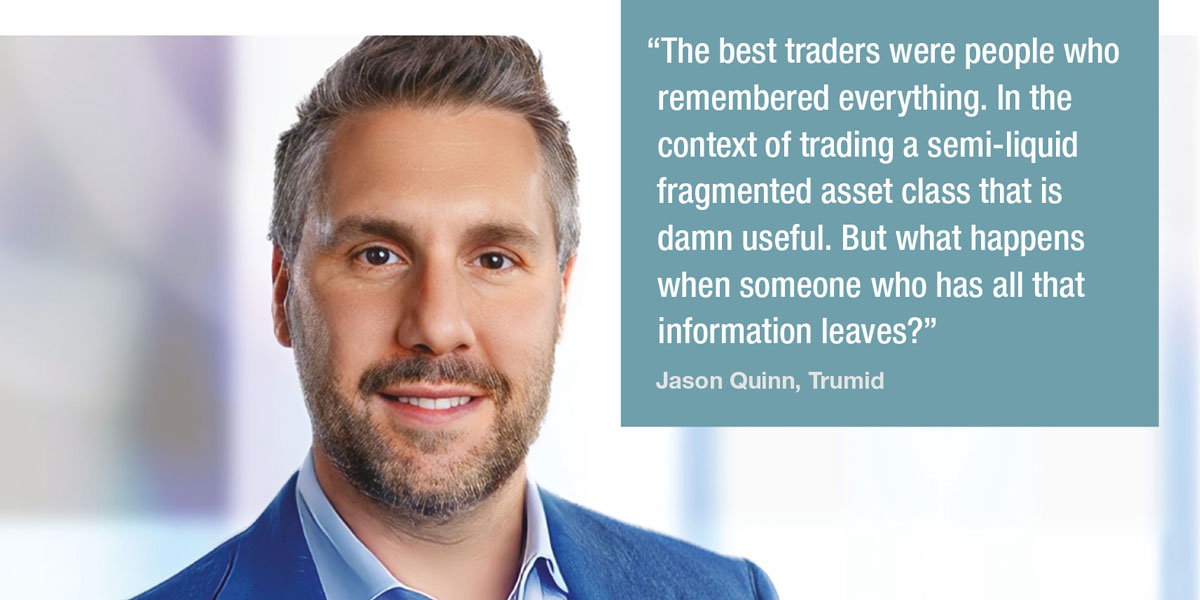
Buy-side traders do not have time to waste, so attention is key to a strong relationship.
We asked buy-side desks about the best ways their counterparts on the sell side support them. Juniorisation of the sales and trading function at investment banks is a real concern, meaning that the experienced sell-side traders are being replaced by younger team members who either lack the relationships needed to help clients get the commitment to coverage that they ask for, or simply cannot make prices in stressed conditions with the confidence that buy-side traders would want.
However, bank traders can really score well with clients if they get their approach right. Specific team members get name-checked as making a real difference to their clients, but so do specific behaviours.
“Post-Covid with a large amount of issuance it was easy for the large franchise banks to sit back and track incoming tickets, not always needing to go out and understand what their clients are looking to achieve or how to position,” says Mike Poole, global head of trading at Jupiter Asset Management. “The better salespeople are the ones who consistently maintain a dialogue and try to instigate business through ideas, not just trying to deal out of their trader’s book, during the quieter periods.”
Eric Böss, global head of trading at Allianz Global Investors, says there particularly good sales traders that help with his firm’s flow, however the effect of dealer sales for Allianz GI at the trading desk is decreasing whilst the role of dealer traders is growing.
“Traders directly provide us with information on flow, axes and react quickly on ongoing inquiries,” he says. “Sales however are focusing more on the communication with the portfolio managers.”

Know your client
In fixed income trading, the sell-side is typically exposed to greater risk when taking on a client’s position and then offloading it than in equity trading. That can create a tension on the sell-side as salespeople are pushed towards pitching their traders’ axes more than they are trying to deliver value to clients. While buy side desks understand this need to offload positions, the approach can also create more noise than liquidity.
“A good coverage consists of traders and sales who know what we’re currently interested in and who reply to our requests promptly, be it in the chat or electronic inquiry,” says Böss. “They don’t waste our time with things we won’t trade anyhow. I think that’s a key differentiator. We don’t want people throwing axes at us in sectors or maturity brackets or ratings that we’re not interested in. So, a constant dialogue and a decent understanding of what we are currently active in, in the OTC markets, and that goes both ways, our traders need to be able to communicate that as well.”
Tim Kurpis, portfolio manager at AllianceBernstein concurs, noting, “A salesperson who adds no value is effectively chucking spaghetti against the wall to see what sticks. The IG bond market is so diverse, you have bonds issued from one year to 40-50 years and perpetuals, you’re never going to have a high hit rate if you’re just sending everything. Start there. You can determine if an area is where somebody’s good, but look at the data, at things like transaction costs. Track hit rates, track electronic trading, which is becoming more important across a lot of markets, to see how strong people are there and evaluate where you are connecting.”

He says good salespeople do not all fit the same mould – some of them are ex-traders, some have been doing the sales role their whole career.
“But what the best do very well is integrating the best offerings from whatever the bank has, with our firm,” he says. “It’s easier said than done.”
The sharper tech edge
Both falling margins and the gradual migration towards electronic trading are impacting the way that sell-side firms provide services to the buy-side and that has an effect upon the needs of asset managers.
“Sell-side firms which stand out from the crowed differentiate themselves by providing us with technology that helps our execution process,” says Böss. “This includes real-time access to axes, reliable quotes – size and price, prompt response on electronic inquiries and the possibility to counter on prices that have been sent. Also potentially direct pricing, which we don’t use.”
Poole notes that every bank seems to be working on their algos and on pricing more competitively.
“They need to weigh up whether they’re happy for these initiatives to be a loss leader to get market share,” he observes. “It feels like portfolio trading is monopolised by a handful and we don’t see anyone jumping into that with both feet at the moment. The market feels a bit overbroked. While there’s been a lot of M&A on the buy side, you’ve got to feel that if volatility stays low and there is not much conviction in the market, you may see some M&A on the sell side as well, which we have seen in equities.”
Internally banks can also struggle to systematise their workflows, which can limit their capacity to translate balance sheet into service levels.
“Dealer balance sheets have not kept pace with the growth of the market,” notes Kurpis. “While developments in electronic trading have been welcomed, developments on voice trading have lagged. It’s why we spend so much time on data aggregation. We want to figure out how to make the smartest outgoing call for the person who’s most likely to find the other side of the trade. There have been a handful of interesting new protocols trying to address more of the voice trading versus electronic trading but with limited success so far.”
Banks have not had great success at similar aggregation efforts, which has meant that sell-side traders often carry the capacity to manage their clients orders with them if they leave a bank.
Jason Quinn, chief product officer at market operator Trumid, spent 12 years on the sell side and says, “The best traders were people who remembered everything. In the context of trading a semi-liquid fragmented asset class that is damn useful. But what happens when someone who has all that information leaves? The institution doesn’t benefit from all the flow that’s going through the franchise, because that capture of data has been a holy grail. Going back 10 to 15 years, we would build systems where a salesperson would get an inquiry, and they would have to go into this window in an app and enter it, so the next time someone asks about that bond, or that sector, they have a database of information, which until that point only lives in the trader. This is still a thing. Unfortunately, we don’t have the luxury of a fully continuous, fully liquid marketplace, where all that information is just captured.”

With traders increasingly becoming a contact point over sales people, it is incumbent upon banks to draw these relationships together.
“I can’t tell you how many times when you’re a market maker in a particular sector or a particular product, some of your clients become accustomed to speaking directly to the trader, ask their bid on a bond, and the salesperson doesn’t even know it happens,” he says. “The ship has already left the dock. So in our design you have visibility over it happening. We notify you and the data is captured by the system. They can see the axes and inventory their clients are receiving from their traders, with their clients, and engage them on that data, with a full negotiation protocol built off of it so the client can watch that negotiation happen in real time. Our digitisation of bilateral negotiations centralises that activity, so that as a salesperson, you have access to it in the future.”
Size isn’t everything
US bank dominance of European capital markets is a longstanding issue, and within the US, Tier 1 banks tend to be so far ahead in the primary markets that they also take pole position in secondary markets as well.
Nevertheless, there are ways for smaller or more regional and local firms to stand up and deliver value to clients.
Kurpis says, “A salesforce, especially at a second tier shop, can add a lot of value to by figuring out how to connect buyers and sellers. There’s a lot of friction that exists in the market for would-be sellers finding would-be buyers. Really good salespeople at second-tier shops would also do really well at bulge-bracket shops because it is their behaviour that adds value. They ask how they can make sure everything they have that’s relevant to me is shown to me so that they’re maximising their hit rates.”
Taking a longer term view of the liquidity being provided can also reap rewards, notes Poole, as it fulfils the role of market maker in tough times, making it in the buy-side interest to engage with the firm at other points.
“Without consistent flow going through the market, I think it has been difficult for banks below the top five or six,” he says. “One or two of the Tier Two banks were very active, and stood up to prices, in periods of volatility such as with AT1 bonds, which we found really useful. Those more opportunistic moments allow them to really swing the bat and make a name for themselves, which is worth noting. Trying to be all things to all people throughout periods of low volatility where there’s not a huge amount of money to be made, especially with the lack of primary, is less viable.”
©Markets Media Europe 2023
©Markets Media Europe 2025













